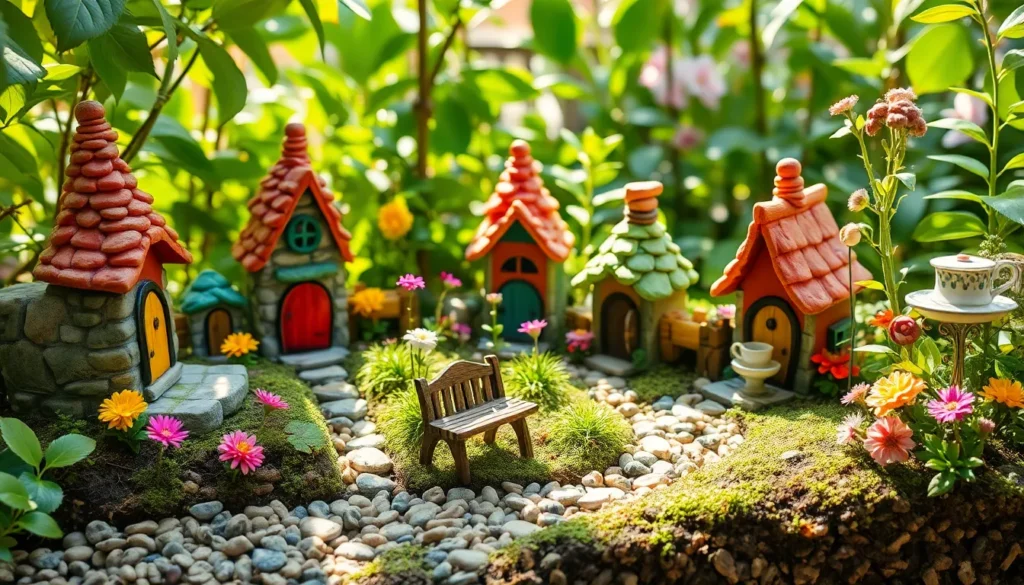We’ve all dreamed of creating our own magical miniature industry where imagination runs wild and tiny fairy tales come to life. Fairy gardens offer the perfect opportunity to transform any outdoor space into an enchanting wonderland that captivates both children and adults alike.
Whether you’re working with a sprawling backyard or a small balcony container, fairy gardens let you create personalized storytelling landscapes using simple materials and creative vision. From whimsical mushroom houses nestled among succulents to tiny bridges spanning miniature streams, these delightful displays bring joy year-round.
We’ll explore creative fairy garden ideas that transform ordinary spaces into extraordinary realms of wonder. You’ll discover how to choose the right plants, create charming fairy accessories, and design magical scenes that spark imagination while requiring minimal maintenance. Get ready to unleash your creativity and build the fairy garden you’ve always envisioned.
Miniature Fairy Houses and Dwellings
Creating enchanting fairy homes transforms our garden spaces into magical realms where imagination comes alive. We can create these whimsical dwellings using natural materials and creative techniques that blend seamlessly with our fairy garden landscapes.
Toadstool and Mushroom Houses
Building toadstool fairy houses brings classic fairytale charm to our miniature worlds. We can create these iconic homes using polymer clay, air-dry clay, or even repurposed materials like small bowls turned upside down. Red caps with white polka dots make the most recognizable mushroom houses, while earth-tone varieties like brown, tan, and cream create more natural-looking forest dwellings.
Crafting multiple mushroom clusters adds depth and visual interest to our fairy gardens. We recommend grouping three to five mushroom houses of varying heights together, creating the appearance of a fairy neighborhood. Small LED tea lights placed inside translucent mushroom houses create a magical glow during evening hours.
Natural mushroom preservation offers an authentic alternative to crafted versions. We can treat real mushrooms with clear sealant or mod podge to extend their lifespan in outdoor fairy gardens. Large bracket fungi and shelf mushrooms work particularly well for fairy house conversions when we carefully hollow out small doorways and windows.
Tree Stump Fairy Homes
Tree stump fairy houses provide rustic charm and natural integration into our garden landscapes. We can hollow out small sections of tree stumps to create cozy fairy dwellings, adding tiny doors made from bark pieces or create wood. Old tree stumps naturally develop interesting textures and moss growth that enhance the magical atmosphere.
Decorating stump homes with natural materials creates authentic woodland aesthetics. We suggest using acorns for chimney caps, twigs for window frames, and small stones for walkways leading to fairy doors. Dried leaves, pine needles, and flower petals make excellent roofing materials that change seasonally.
Multi-level stump houses maximize vertical space in our fairy gardens. We can carve multiple doorways at different heights to create apartment-style fairy housing. Small wooden ladders or twig staircases connect the levels, while tiny balconies made from bark pieces add architectural detail.
Stone and Pebble Cottages
Stone fairy cottages offer durability and timeless appeal in our outdoor fairy gardens. We can stack flat river rocks or use natural fieldstones to build miniature houses that withstand weather changes throughout the seasons. Mortar or strong outdoor adhesive helps secure the stones while maintaining a natural appearance.
River rock construction creates smooth, rounded fairy homes with organic shapes. We recommend selecting stones in similar color families like gray, brown, or tan to maintain visual cohesion. Small gaps between rocks can serve as windows, while larger openings become doorways that we can accent with tiny wooden doors.
Pebble mosaic techniques add decorative elements to our stone fairy houses. We can create colorful patterns using small pebbles pressed into clay or cement bases around doorways and windows. Beach glass, tiny shells, and smooth ceramic pieces make beautiful accent materials for coastal-themed fairy cottages.
Enchanting Fairy Garden Pathways
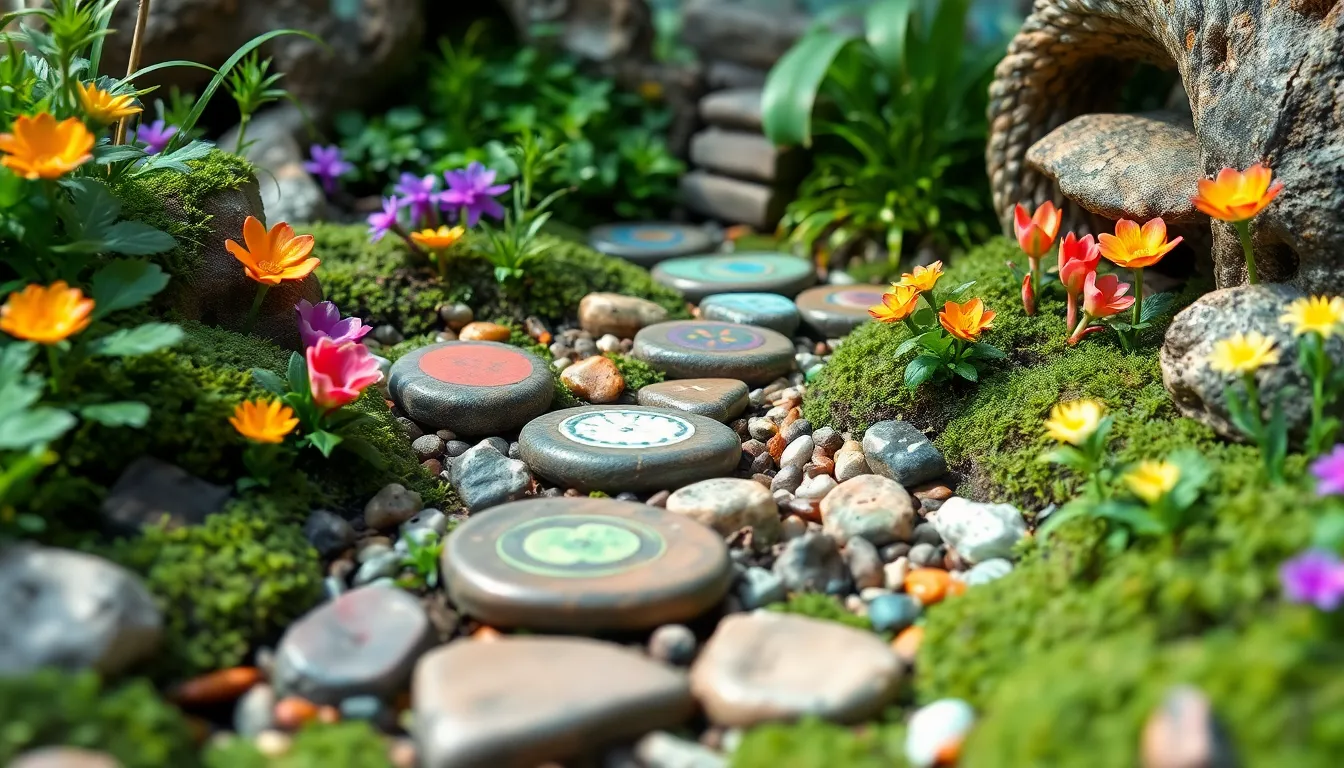
Pathways serve as the magical arteries that connect different sections of your fairy garden while guiding visitors through your miniature wonderland. These walkways transform ordinary garden spaces into enchanting landscapes that invite exploration and spark imagination.
Stepping Stone Walkways
Stepping stones create whimsical pathways that add instant charm to any fairy garden design. We recommend using painted stones decorated with fairy-themed designs or inspiring quotes to enhance the magical atmosphere. Natural stones work beautifully as well, providing an organic foundation that blends seamlessly with garden plants and accessories.
Position these stones in gentle curves rather than straight lines to create a more natural, meandering effect. Spacing them about 12-18 inches apart allows for comfortable navigation while maintaining the miniature scale appropriate for fairy gardens. Paint them with weather-resistant acrylics in soft pastels or earth tones to complement your garden’s color scheme.
Pebble and Gravel Trails
Pebble and gravel combinations offer versatile pathway answers that require minimal maintenance while delivering maximum visual impact. These natural materials create winding trails that feel authentic and blend effortlessly with various garden settings. Small river pebbles mixed with fine gravel provide texture variation that catches light beautifully throughout different times of day.
Create depth by using different sized pebbles, placing larger ones along the edges and smaller ones in the center. This technique helps define the pathway boundaries while preventing materials from scattering into surrounding garden beds. Consider using contrasting colors like white pebbles against dark gravel for added visual interest.
Miniature Brick Pathways
Miniature brick pathways bring structured elegance to fairy gardens through their charming, organized appearance. These pathways use small bricks or rectangular stones arranged in traditional patterns like herringbone or running bond. We find that creating these structured elements adds a delightful contrast to the organic shapes of plants and natural accessories.
Build your brick pathway by laying stones in sand or soil for stability, ensuring each piece sits level with its neighbors. Leave small gaps between bricks to allow for moss or tiny ground cover plants to establish naturally. This technique creates an aged, established look that suggests your fairy community has been thriving for years.
Magical Water Features for Fairy Gardens
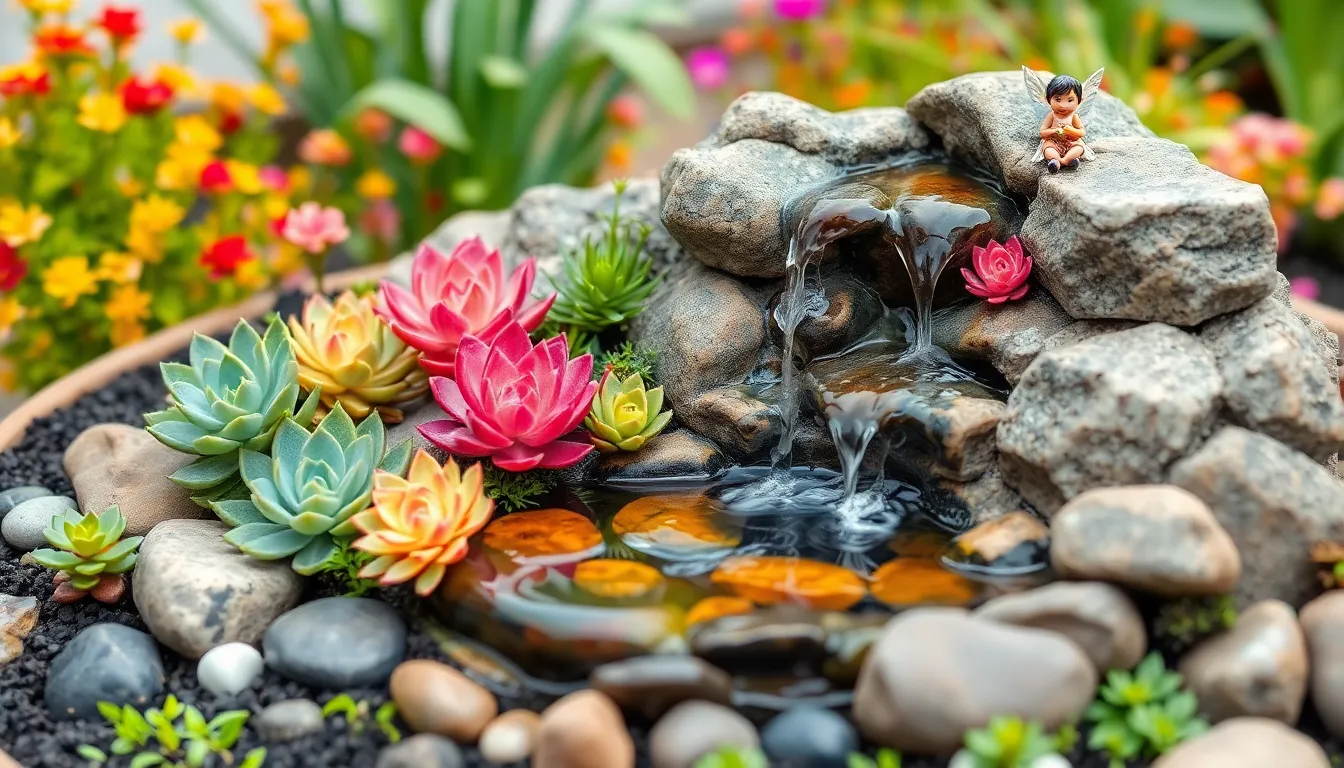
Water features transform ordinary fairy gardens into captivating wonderlands that sparkle with movement and sound. These enchanting elements bring life to our miniature landscapes while creating focal points that draw both fairies and admirers alike.
Tiny Pond and Lake Ideas
Miniature ponds serve as perfect centerpieces for our fairy garden designs. We can create these charming water features using shallow containers or repurposed birdbaths as the foundation. Small figurines positioned around the pond’s edge enhance the fairy theme while creating storytelling opportunities.
Lake landscaping adds depth and realism to our fairy garden scenes. Small rocks and pebbles arranged around the water’s edge create beach-like areas that mimic natural shorelines. This technique gives our miniature water features the appearance of larger bodies of water.
Plants and decorative elements complete our tiny pond designs. Succulents planted around the perimeter provide year-round greenery that won’t overwhelm the small scale. Moss tucked between stones creates a natural, aged appearance that makes our ponds look like they’ve existed for years.
Mini Waterfall Creations
DIY waterfalls bring ever-changing movement to our fairy gardens through simple pump systems. We can use small pumps to circulate water from elevated positions down to collection basins below. The smartpond® 80 GPH Premium Fountain Pump provides reliable water circulation for these miniature installations.
Natural materials create the most convincing waterfall structures in our designs. Stone and wood pieces arranged in cascading patterns blend seamlessly with surrounding garden elements. Moss and tiny plants tucked between rocks create lush backdrops that make our waterfalls appear naturally formed.
Elevation changes maximize the visual impact of our mini waterfalls. Raised garden beds provide the height difference needed for effective water flow. Cement materials can be shaped into custom tub fountains that serve as both water source and decorative element.
Birdbath Fairy Pools
Birdbath conversions offer instant fairy pools with minimal construction effort. We transform existing birdbaths by adding fairy-sized furniture and plants around the basin. This approach creates immediate focal points that anchor our entire garden design.
Decorative elements enhance the tranquil atmosphere of our fairy pools. Small stones and shells arranged in the water add visual interest while creating realistic aquatic environments. These details make our pools appear as natural gathering spots for our fairy inhabitants.
Surrounding landscaping completes our birdbath fairy pool installations. Plants positioned around the base create privacy screens and natural boundaries. This technique integrates our water features into the broader garden design while maintaining the magical fairy garden aesthetic.
Whimsical Fairy Garden Furniture
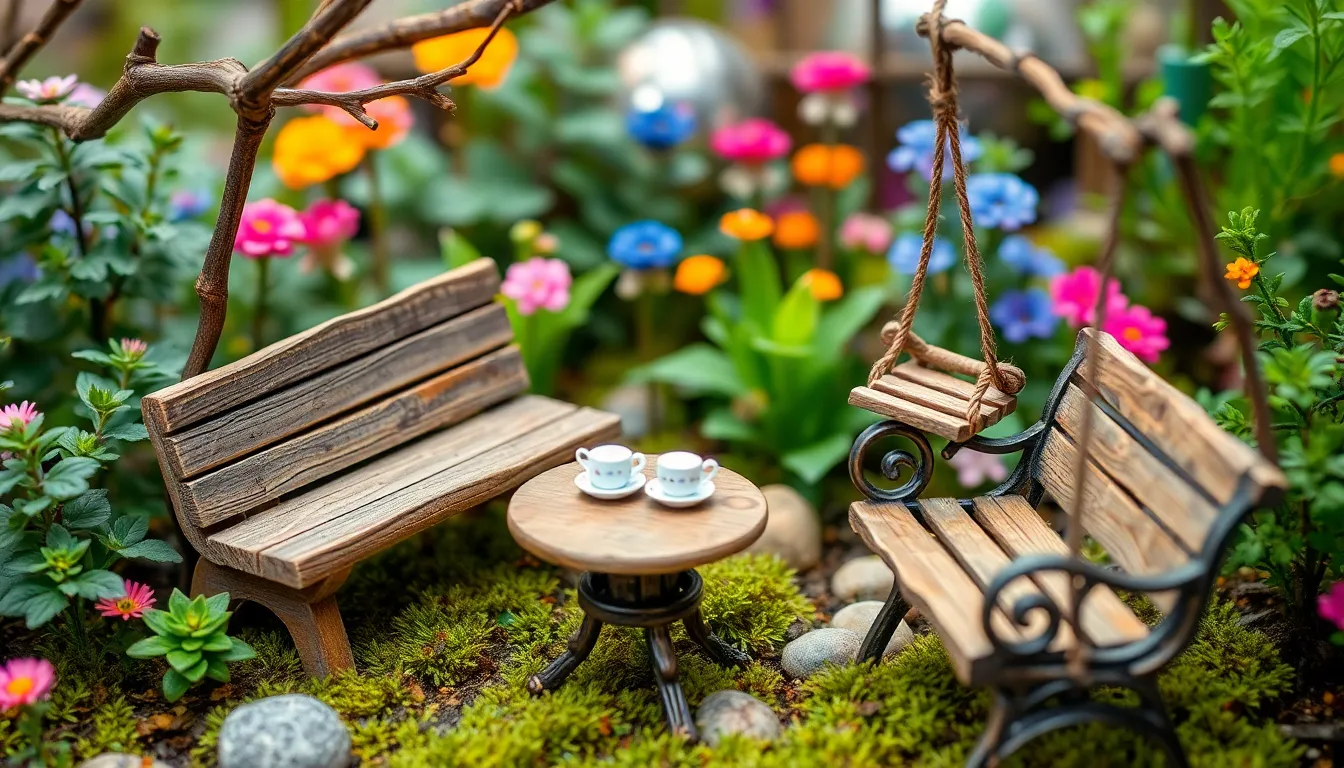
Creating enchanting seating areas and playful spaces brings fairy gardens to life with magical charm. We’ll explore furniture pieces that transform miniature landscapes into inviting fairy gathering spots.
Miniature Benches and Seating
Rustic wooden benches create perfect resting spots for our fairy visitors throughout the garden. We can create these charming pieces from natural twigs and branches, or purchase ready-made options from create stores and garden centers. Materials like resin and repurposed household items offer durability while maintaining that whimsical appeal we’re seeking.
Styling options range from simple wooden plank designs to ornate wrought iron replicas that suit various garden themes. Log-style seating adds rustic charm to woodland fairy gardens, while elegant curved benches complement more formal miniature landscapes. Grouping multiple benches creates social gathering areas where fairies can rest and socialize.
Strategic placement near fairy houses or along pathways establishes natural focal points that draw the eye through our garden design. We recommend positioning benches facing water features or scenic garden views to enhance the storytelling potential of each miniature scene.
Tiny Tables and Tea Sets
Miniature tea party scenes bring social atmosphere and playful charm to our fairy garden displays. We can arrange tiny tables with complete ceramic, plastic, or metal tea sets featuring intricate detailing that captures authentic dining experiences. These vignettes become favorite focal points that invite imaginative storytelling.
Table varieties include round bistro styles, rectangular picnic tables, and ornate pedestal designs that accommodate different fairy gathering scenarios. Pairing tables with matching chairs creates cohesive dining areas, while mixing furniture styles adds eclectic charm to our miniature landscapes.
Tea set arrangements work best when we include cups, plates, saucers, and tiny serving pieces that suggest ongoing fairy celebrations. Adding miniature food items like tiny cakes or fruit enhances the realistic appeal of these charming dining scenes.
Fairy Swings and Play Areas
Handcrafted swings made from twigs, rope, or resin materials add ever-changing movement to our fairy gardens. We can hang these delightful pieces from miniature trees, decorative posts, or specially designed swing sets that complement our garden’s overall theme. Natural materials like bent twigs create authentic woodland appeal.
Play area elements such as slides, seesaws, and tiny sandboxes encourage fairies to linger and enjoy extended visits to our gardens. These interactive features spark creativity while adding visual interest through varied heights and textures throughout the industry.
Installation techniques involve securing swings at appropriate fairy scale heights and ensuring play equipment remains stable during weather changes. We suggest grouping multiple play elements to create dedicated fairy recreation zones that become natural storytelling focal points within our garden design.
Creative Plant Choices for Fairy Gardens
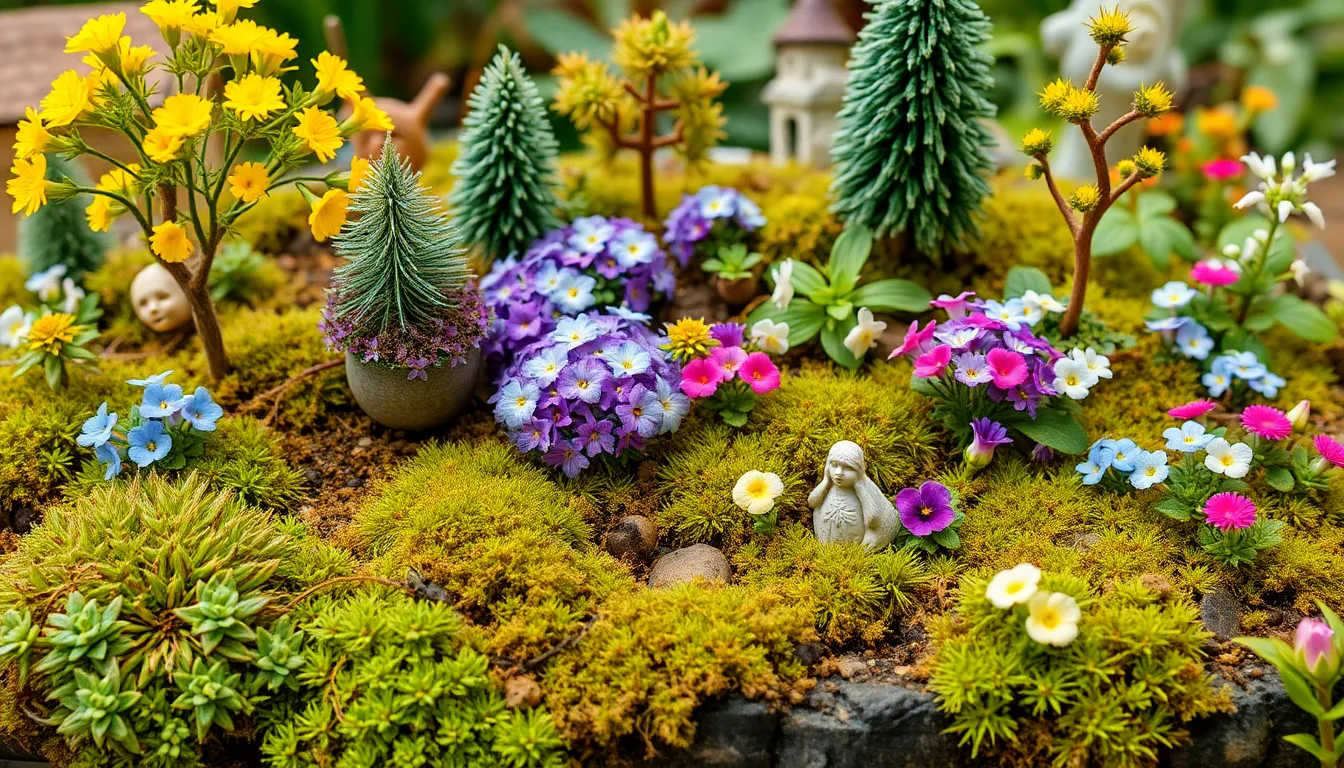
Selecting the right plants creates the foundation for a magical fairy garden that thrives year-round. We’ll explore plant varieties that maintain their charm while providing the perfect scale and atmosphere for our miniature fairy realms.
Low-Growing Ground Cover Plants
Creeping Thyme transforms fairy gardens into aromatic wonderlands while spreading readily to create natural pathways between fairy houses. This hardy ground cover releases a delightful fragrance when stepped on and produces tiny purple flowers that attract beneficial insects to our garden spaces.
Creeping Jenny offers golden foliage that adds warm glows to shaded fairy garden areas throughout the growing season. Its trailing nature makes it perfect for cascading over miniature walls or filling gaps between stepping stones where fairies might wander.
Moss creates the most authentic fairy tale atmosphere by covering stones, tree stumps, and other garden features with its velvety texture. We can establish moss colonies by mixing buttermilk with existing moss and painting the mixture onto surfaces where we want coverage.
Miniature Hosta varieties provide broad leaves that create natural fairy umbrellas while tolerating shade conditions perfectly. These perennials return each spring stronger than before and develop interesting leaf patterns that add visual depth to our garden designs.
Miniature Trees and Shrubs
Dwarf Conifers establish miniature forests within our fairy gardens using varieties like dwarf Alberta spruce or miniature juniper specimens. These evergreen options maintain their structure year-round and can be pruned into bonsai-style trees that perfectly suit fairy proportions.
Miniature Rose Bushes bring romance and fragrance to fairy gardens through compact varieties that produce full-sized blooms on tiny plants. We recommend choosing disease-resistant cultivars like ‘Gourmet Popcorn’ or ‘Red Cascade’ that won’t overwhelm the surrounding fairy accessories.
Dwarf Boxwood creates perfect miniature hedges and topiary shapes that can be maintained through regular pruning sessions. This versatile shrub responds well to shaping and provides structure that frames fairy garden scenes beautifully throughout all seasons.
Japanese Maple cultivars offer stunning seasonal color changes in varieties like ‘Crimson Queen’ or ‘Inaba Shidare’ that stay naturally compact. These ornamental trees provide shade for fairy dwellings while creating dramatic backdrops with their intricate branch patterns.
Colorful Flowering Options
Pansies and Petunias deliver vibrant color displays in fairy gardens through their wide range of available hues and compact growing habits. These annuals bloom continuously throughout their growing season and can be replaced seasonally to maintain fresh color schemes.
Violas and Forget-Me-Nots add delicate touches to fairy gardens with their small, perfectly proportioned flowers that complement miniature garden scales. These charming blooms often self-seed, creating naturalized patches that enhance the wild magic atmosphere.
Calibrachoa varieties produce masses of tiny petunia-like flowers that cascade beautifully from fairy garden containers or hanging elements. These heat-tolerant plants bloom from spring until frost and come in many color combinations perfect for creating themed fairy garden areas.
Alyssum cultivars form fragrant carpets of tiny white, pink, or purple flowers that attract beneficial insects while providing ground-level interest. This low-maintenance annual reseeds readily and creates natural-looking flower meadows within our fairy garden landscapes.
DIY Fairy Garden Accessories
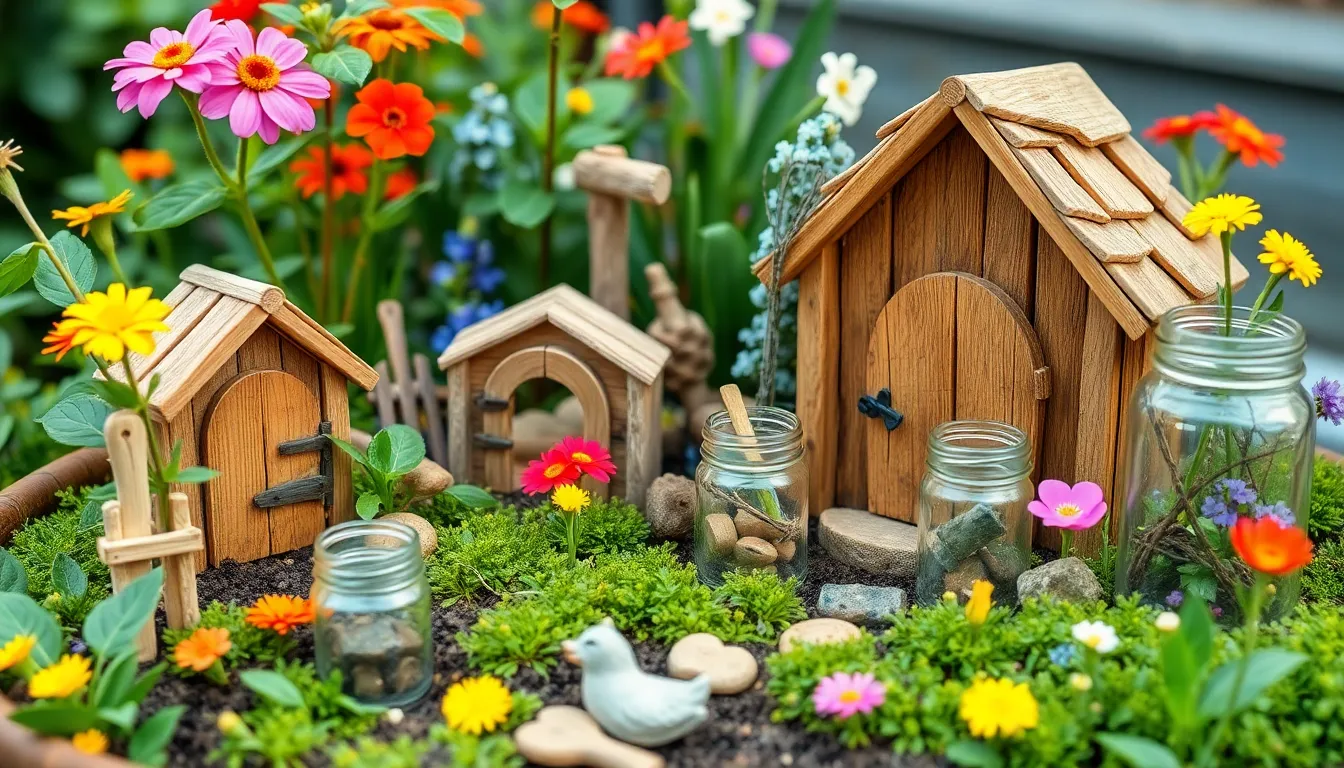
Creating your own fairy garden accessories transforms your miniature industry into a truly personal magical area. We’ll explore handcrafted elements that bring enchantment without breaking the budget.
Handmade Fairy Doors and Windows
Natural materials like bark and twigs offer the perfect foundation for authentic fairy entrances. We create charming doors using small pieces of wood, shaping them to fit naturally against tree trunks or fairy houses. Bark provides excellent texture for rustic door designs, while thin branches create decorative frames around miniature windows.
Small hinges aren’t necessary since fairy doors remain stationary, allowing us to focus on decorative details instead. We attach tiny pebbles as door handles and use moss to create weathered effects around the frames. Twigs arranged in cross patterns make excellent window panes, while acorns serve as perfect fairy door knockers.
Crafted Garden Tools and Props
Miniature garden tools bring realistic touches to our fairy landscapes while showcasing crafting creativity. We fashion tiny rakes using popsicle sticks as handles and thin twigs bound together for the rake head. Clay becomes an excellent material for sculpting small trowels and watering cans that look authentic in fairy hands.
Small stones and shells transform into personalized garden signs with painted fairy names or directional markers. We create miniature plant markers using toothpicks topped with tiny leaf cutouts. Fishing line stretched between willow twigs makes whimsical washing lines where fairy clothes can appear to dry in the garden breeze.
Repurposed Household Items
Mason jars become versatile fairy garden elements through creative repurposing techniques. We transform these containers into mini planters using decoupage methods, creating unique focal points throughout the garden. Wicker baskets serve as instant fairy gardens when filled with small plants and decorative stones.
Glass fish bowls and containers create enclosed fairy scenes that protect delicate figurines from weather. We layer crushed rocks in the bottom for drainage, then add soil and tiny plants to build complete miniature worlds. These glass environments work particularly well for indoor fairy gardens or protected outdoor spaces.
Seasonal Fairy Garden Themes
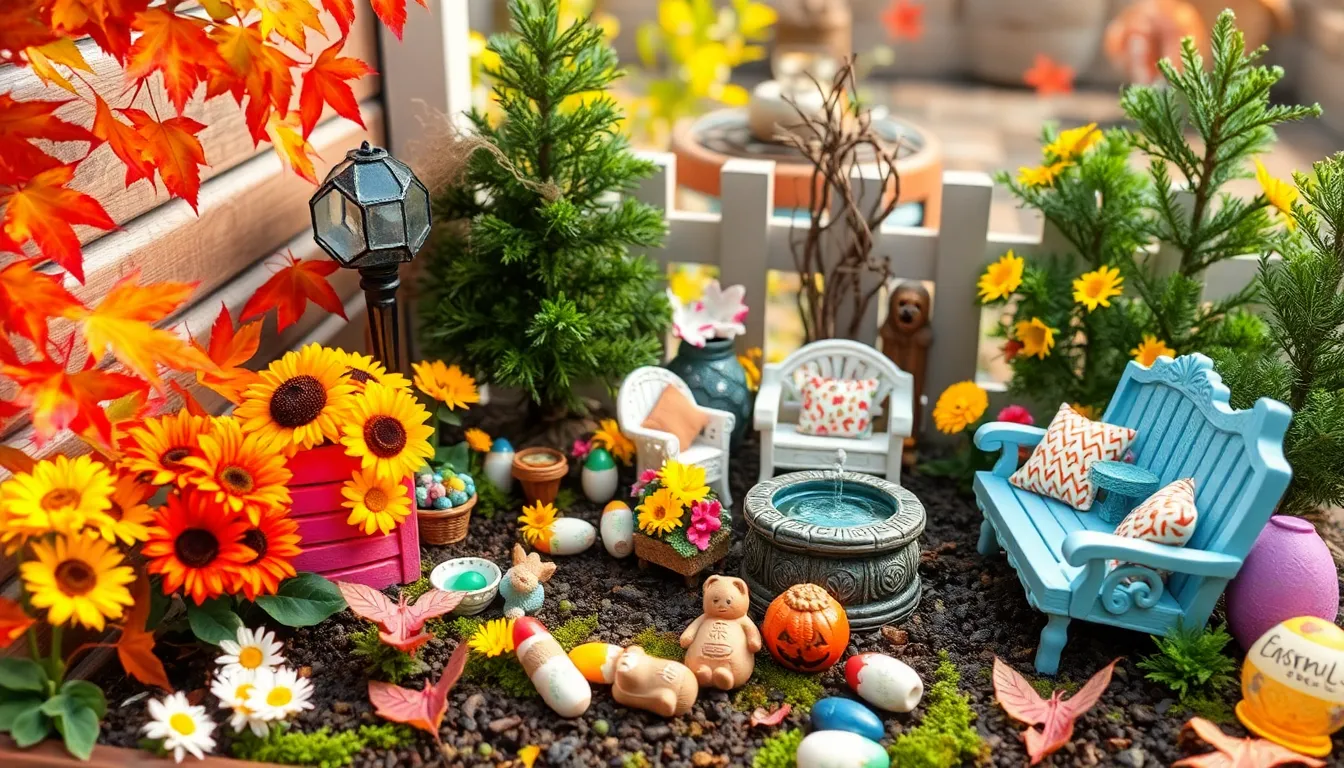
Seasonal fairy garden themes transform your miniature industry throughout the year, creating ever-changing magical experiences that reflect nature’s rhythms.
Spring and Summer Designs
Vibrant flower displays make spring and summer fairy gardens burst with life and color. We recommend using daisies and sunflowers as they create a cheerful backdrop while maintaining appropriate scale for fairy-sized inhabitants. These blooms naturally attract beneficial insects like butterflies, adding movement and authenticity to your garden scenes.
Small water features enhance the garden’s ambiance during warmer months. A babbling brook created with a small recirculating pump or a tiny pond using a shallow ceramic dish brings cooling sounds and visual interest. Position these features near seating areas or fairy houses to create gathering spots where magical conversations might occur.
Miniature furniture and accessories complete the whimsical fairy village atmosphere. Tiny benches, tables, and umbrellas provide shade and comfort during sunny days. Choose weather-resistant materials like sealed wood or metal to ensure your accessories survive summer storms and daily watering routines.
Autumn and Winter Decorations
Natural autumn elements create an earthy, cozy atmosphere for fall fairy gardens. Fallen leaves, acorns, and pinecones scattered around fairy houses mimic nature’s seasonal changes while providing free decorating materials. These elements gradually break down, enriching your garden soil as they decompose.
Winter magical touches transform your fairy garden into a frosty wonderland. Snowflakes cut from white paper or plastic, artificial icicles, and frosty glass beads add sparkle without melting. Evergreen plants like miniature spruces or dwarf pines provide structure and color when other plants go dormant.
Fairy lights create a warm glow against winter’s stark industry. Battery-powered LED strings wrapped around miniature trees or tucked behind fairy houses extend your garden’s beauty into evening hours. Solar-powered options eliminate the need for battery changes while providing eco-friendly illumination.
Holiday-Themed Fairy Gardens
Christmas fairy gardens become holiday wonderlands with fairy-sized Christmas trees and festive decorations. Tiny ornaments hung from miniature evergreens, festive lights strung between fairy houses, and small snowmen figurines create a magical holiday scene. Santa figurines and reindeer accessories complete the Christmas theme while maintaining appropriate scale.
Halloween fairy gardens embrace spooky elements with miniature ghosts, bats, and spiders strategically placed around autumn foliage. Pumpkins ranging from tiny gourds to miniature carved jack-o-lanterns create seasonal backdrops. Orange and black decorative elements like tiny cauldrons or witch hats add playful frightening touches.
Easter fairy gardens celebrate spring’s renewal with pastel-colored eggs nestled among fresh flowers. Tiny bunny figurines hopping along fairy pathways and spring flowers like crocuses or daffodils create a festive atmosphere. Miniature Easter baskets filled with colorful eggs complete the holiday theme while welcoming spring’s arrival.
Container Fairy Garden Ideas
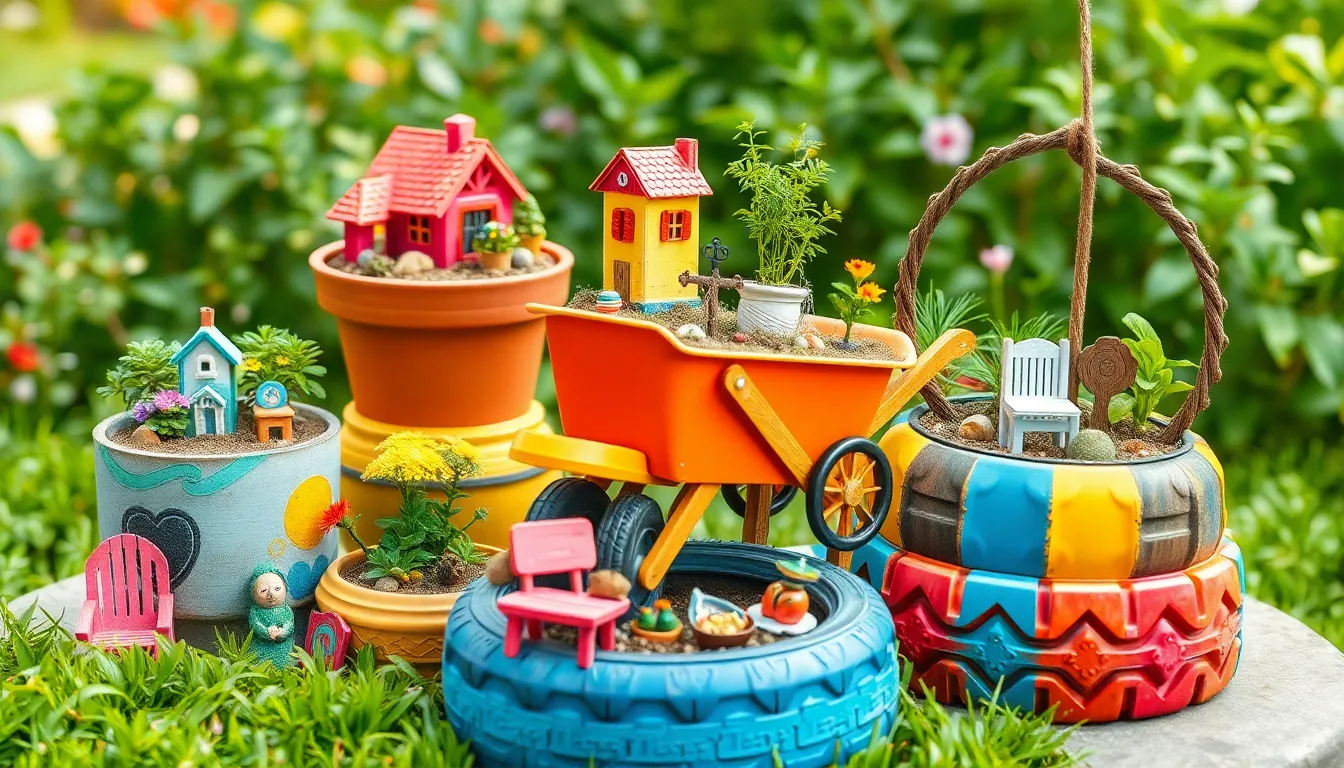
Container fairy gardens offer incredible flexibility for creating magical spaces wherever you are. We’ll explore how ordinary containers can become extraordinary fairy realms with the right design approach.
Potted Fairy Garden Designs
Flowerpot transformations turn everyday containers into whimsical fairy landscapes by combining small houses, plants, and carefully chosen accessories. We recommend starting with ordinary flowerpots and adding tiny furniture pieces alongside pathways made from pea gravel or aquarium stones for authentic detail.
Themed garden concepts elevate your container designs by focusing on exact stories like camping adventures or farm life scenes. Small toys and themed accessories enhance these narratives while creating cohesive visual experiences that spark imagination.
Multilevel container arrangements maximize your vertical space by stacking containers or using tiered planters to create depth and visual interest. These layered designs allow us to incorporate more fairy elements while maintaining proper plant spacing for healthy growth.
Terrarium Fairy Worlds
Glass container ecosystems create self-sustaining miniature environments that require minimal maintenance while providing maximum enchantment. We build these fairy worlds using layers of soil, carefully selected plants, and decorative objects that mimic natural fairy habitats.
Enclosed fairy environments offer unique advantages including humidity control and protection from outdoor elements. These contained systems allow us to experiment with delicate plants and accessories that might not survive in open garden settings.
Miniature industry layering involves strategic placement of materials to create realistic depth and dimension within glass containers. Each layer serves both functional and aesthetic purposes while contributing to the overall fairy garden network.
Repurposed Container Options
Vintage wheelbarrows and wagons transform into charming fairy garden containers that add rustic character to any space. These repurposed items provide ample planting area while their weathered appearance enhances the magical garden aesthetic.
Old birdbath conversions create elevated fairy garden displays that serve as stunning focal points in larger landscapes. We personalize these containers with small decorative elements and fairy-sized accessories for enhanced visual appeal.
Wooden fruit box gardens offer cozy fairy home settings when filled with appropriate plants and miniature decorations. These containers provide natural charm while offering sufficient depth for plant root systems and fairy garden accessories.
Creative broken pot answers transform damaged containers into unique planters or decorative garden elements rather than discarding them. We use these pieces strategically within fairy gardens to create interesting terrain features and planting opportunities.
Upcycled tire gardens become teacup-style fairy containers through creative transformation techniques and colorful paint applications. These eco-friendly options demonstrate how everyday items can become magical fairy garden foundations with minimal investment.
Lighting Ideas for Fairy Gardens
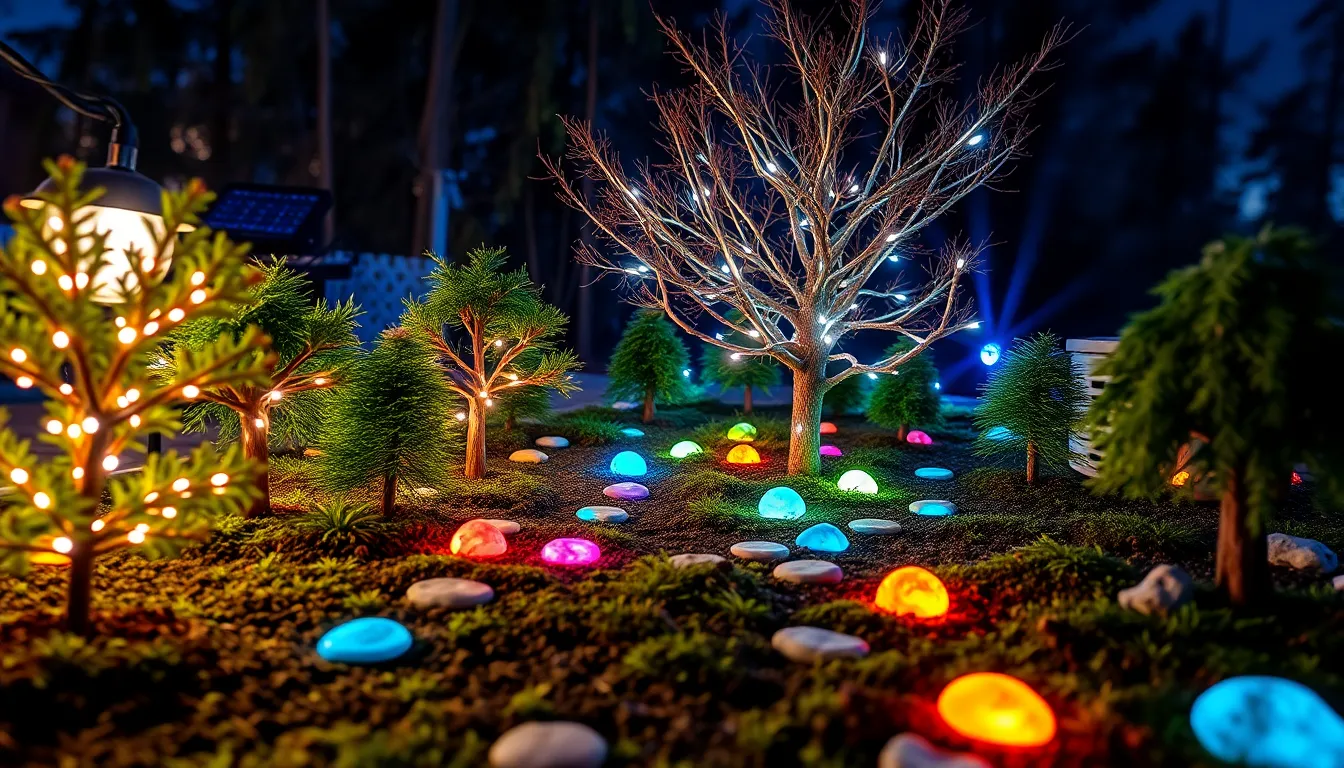
Strategic lighting transforms ordinary fairy gardens into enchanting nighttime wonderlands. We’ll explore three essential lighting approaches that create magical ambiance while remaining practical and energy efficient.
Solar-Powered Fairy Lights
Solar powered fairy lights offer the perfect combination of environmental responsibility and magical illumination for our fairy gardens. These energy efficient lights harness sunlight during the day to create stunning nighttime displays without increasing electricity costs.
Placement strategies make all the difference when installing solar fairy lights. We recommend positioning them under plants or nestled within gravel areas to create subtle magical glowing effects. The lights blend seamlessly with natural garden elements while providing gentle illumination that won’t overpower delicate fairy garden features.
Maintenance requirements remain minimal since solar lights operate independently of electrical systems. Battery life typically extends through entire nights during peak growing seasons, ensuring consistent magical ambiance for our fairy inhabitants.
LED String Light Options
LED string lights provide versatile lighting answers that adapt to any fairy garden design or layout. We can drape these flexible lights over miniature trees to create canopy effects or weave them through flower beds for ground level illumination.
Architectural highlighting becomes possible when we wrap LED strings around arched structures or fairy houses. The lights accentuate garden features while creating depth and visual interest throughout the miniature industry.
Creative installation techniques include threading lights through pathway borders or creating light curtains between garden sections. We’ve found that varying the spacing and height of LED strings produces more ever-changing lighting effects than uniform placement patterns.
Glow-in-the-Dark Elements
Glow in the dark components add mystical evening charm without requiring electricity or maintenance. We incorporate these luminescent materials through painted stones, pathway markers, or decorative accents that charge during daylight hours.
Pathway illumination becomes effortless when we use glow in the dark stones to outline walking routes through our fairy gardens. The stones provide gentle guidance for evening garden viewing while maintaining the magical atmosphere we’re creating.
Strategic placement of glowing elements near fairy houses or water features creates focal points that draw attention to key garden areas. We’ve discovered that combining different glow colors produces more interesting visual effects than using single color schemes throughout the garden space.
Maintenance Tips for Fairy Gardens
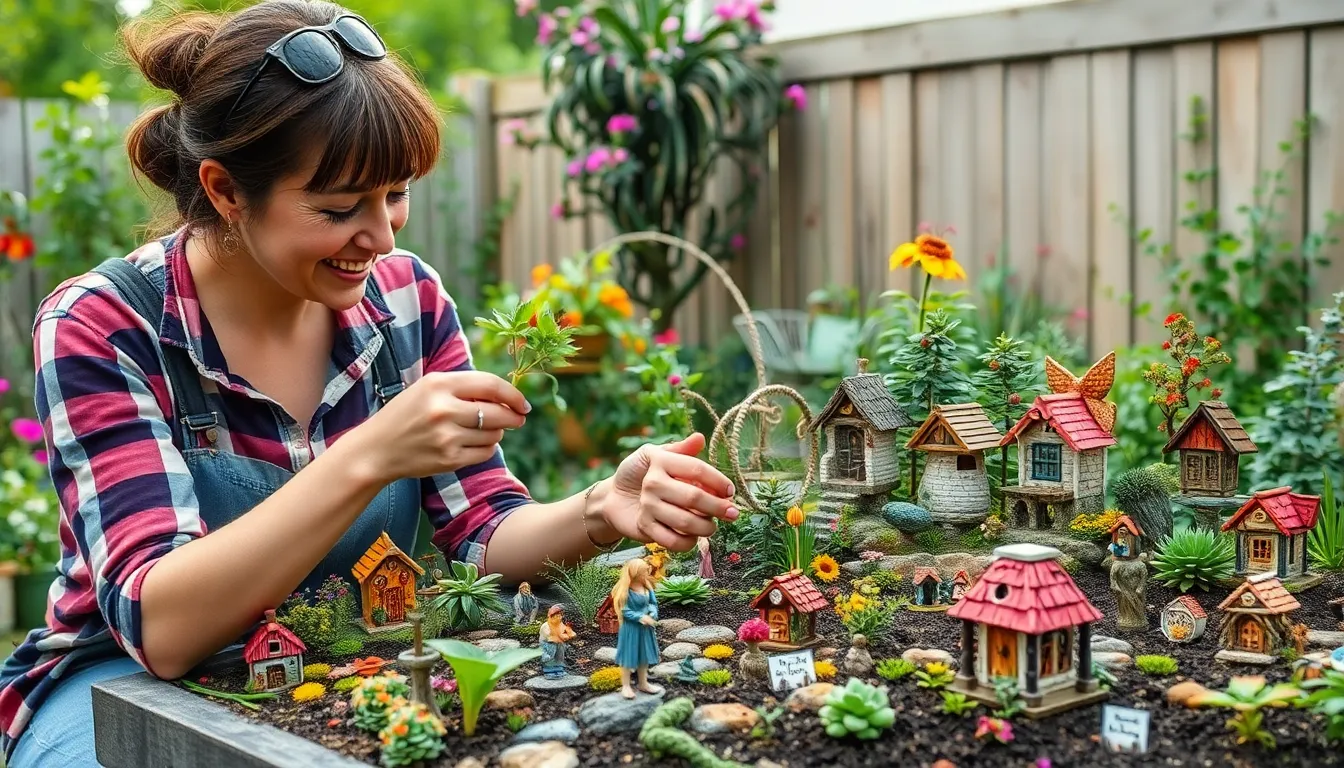
We’ll ensure our fairy gardens stay enchanting and healthy year-round with proper care techniques. These miniature wonderlands require exact attention to thrive and maintain their magical appeal.
Watering and Plant Care
Watering becomes effortless when we use small watering cans or spray bottles to keep soil consistently moist without creating waterlogged conditions. Overwatering leads to root rot and fungal diseases that can destroy our carefully crafted landscapes. We should check soil moisture daily by inserting our finger about an inch deep into the soil.
Plant care involves regular pruning to maintain proper shape and encourage healthy new growth throughout the growing season. Small scissors or specialized pruning shears work perfectly for trimming miniature plants without damaging surrounding accessories. We’ll remove dead flowers and yellowing leaves promptly to prevent disease spread.
Weeding requires consistent attention to prevent unwanted plants from competing with our chosen fairy garden specimens. Regular removal of weeds maintains the garden’s pristine appearance while ensuring our miniature plants receive adequate nutrients and water. We can use tweezers or small hand tools to carefully extract weeds without disturbing nearby decorative elements.
Seasonal Upkeep Tasks
Spring maintenance focuses on plant growth renewal and refreshing weathered accessories after winter dormancy. We’ll inspect all plants for winter damage and replace any that didn’t survive the cold months. Fresh mulch and new soil amendments help establish strong growing conditions.
Summer care emphasizes maintaining plant health during hot weather and preventing heat stress in our miniature landscapes. Additional watering frequency becomes necessary during extended dry periods. We should relocate containers to shadier locations if plants show signs of heat damage.
Fall preparation involves cleaning up debris and preparing plants for their dormant winter period. We’ll remove fallen leaves that could harbor pests or diseases. Trimming back perennial plants helps them conserve energy during colder months.
Winter protection includes shielding plants from frost damage while maintaining adequate moisture levels in the soil. Covering tender plants with small cloches or moving containers to protected areas prevents freeze damage. We should continue light watering since winter winds can dry out soil quickly.
Protecting Miniature Elements
Cleaning decorative accessories regularly prevents dust buildup that can dull their magical appearance over time. We use soft brushes or damp cloths to gently remove accumulated dirt from fairy houses, furniture, and other miniature elements. Monthly cleaning sessions keep everything looking fresh and inviting.
Pest control monitoring helps us catch problems early before they damage plants or contaminate our fairy garden scenes. Aphids and snails commonly target tender fairy garden plants. Natural remedies like neem oil or insecticidal soap effectively control pests without harming beneficial insects or disrupting the garden’s network.
Weather protection involves securing lightweight accessories during storms and repositioning delicate elements when necessary. We anchor small items with hidden weights or temporary ties during windy conditions. Bringing removable decorations indoors during severe weather prevents damage and extends their lifespan.
Conclusion
Creating your own fairy garden opens the door to endless magical possibilities right in your backyard or living space. We’ve explored everything from charming miniature houses and enchanting pathways to carefully selected plants and twinkling lights that bring these tiny worlds to life.
The beauty of fairy gardening lies in its flexibility – whether you’re working with a sprawling outdoor area or a simple container on your windowsill you can create something truly special. Every element we’ve discussed works together to create an immersive experience that sparks imagination and provides a peaceful retreat from daily life.
With proper planning and regular care your fairy garden will continue to evolve and enchant for years to come. We encourage you to start small experiment with different ideas and most importantly have fun as you bring your own piece of magic into the industry.
Frequently Asked Questions
What is a fairy garden and how do I start one?
A fairy garden is a miniature landscape designed to create magical scenes that inspire imagination and storytelling. You can start by choosing any outdoor space – from large backyards to small balconies. Begin with selecting appropriate small plants, crafting or purchasing miniature accessories like fairy houses, and designing captivating scenes. The key is unleashing your creativity while keeping maintenance simple.
What materials can I use to make fairy houses?
You can create fairy houses using various materials including polymer clay for toadstool and mushroom houses, tree stumps for rustic dwellings, and river rocks or stones for durable cottages. Repurposed household items like bark, twigs, and even broken pottery can be transformed into charming fairy homes. Natural materials blend seamlessly with garden landscapes.
How do I create pathways in my fairy garden?
Fairy garden pathways can be made using stepping stones with fairy-themed designs, pebble and gravel trails that blend naturally, or miniature brick walkways for elegance. These pathways serve as magical connections between different garden sections, enhancing exploration and adding structure to your miniature landscape while inviting creativity in design.
What plants work best for fairy gardens?
Choose low-growing ground cover plants like Creeping Thyme and Creeping Jenny for aromatic appeal, moss for authentic fairy tale atmosphere, and miniature trees such as dwarf conifers. Colorful flowering options like pansies, petunias, and alyssum provide vibrant displays. Select plants that maintain appropriate scale and create the perfect miniature realm atmosphere.
How can I add water features to my fairy garden?
Create tiny ponds using shallow containers or repurposed birdbaths, enhanced with small figurines and natural landscaping. Build DIY mini waterfalls using small pumps and natural materials for movement and sound. Convert birdbaths into fairy pools with miniature furniture and decorative elements to create tranquil gathering spots that transform gardens into captivating wonderlands.
What lighting options work for fairy gardens?
Use solar-powered fairy lights for eco-friendly illumination without electricity costs, LED string lights for versatile creative installation, and glow-in-the-dark elements for low-maintenance nighttime charm. Strategic lighting placement transforms fairy gardens into enchanting nighttime wonderlands, guiding visitors through the garden while enhancing the magical ambiance and visual appeal.
How do I maintain my fairy garden throughout the seasons?
Regular watering and plant care include maintaining soil moisture and pruning for healthy growth. Perform seasonal tasks: spring cleaning and planting, summer watering and pest monitoring, fall preparation and leaf removal, winter protection from harsh weather. Clean decorative accessories regularly, monitor for pests, and protect miniature elements from weather damage.
Can I create a fairy garden in containers?
Yes, container fairy gardens offer flexibility using flowerpots, terrariums, vintage wheelbarrows, or repurposed items like broken pots and old birdbaths. Transform ordinary containers by combining small houses, plants, and accessories. Create multilevel arrangements to maximize vertical space or terrarium fairy worlds as self-sustaining ecosystems requiring minimal maintenance.
How can I personalize my fairy garden with DIY accessories?
Craft handmade fairy doors and windows using natural materials like bark and twigs, create miniature garden tools and props for realism, and repurpose household items such as mason jars and glass bowls. These DIY accessories enhance charm while allowing creative expression, making each fairy garden a truly personal magical space.
What seasonal themes can I incorporate into my fairy garden?
Spring and summer feature vibrant flower displays with daisies and sunflowers plus small water features. Autumn uses natural elements like fallen leaves and pinecones for coziness. Winter adds artificial snowflakes and fairy lights for frosty charm. Holiday themes include Christmas decorations, Halloween spooky elements, and Easter celebrations for year-round magical experiences.

